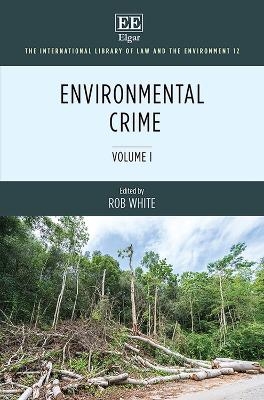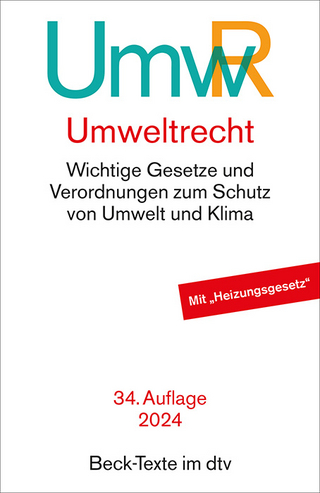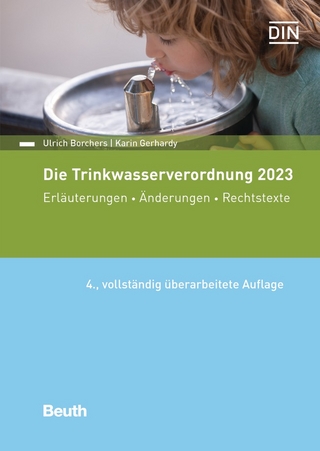
Environmental Crime
Edward Elgar Publishing Ltd (Verlag)
978-1-78897-062-4 (ISBN)
Edited by Rob White, Emeritus Distinguished Professor of Criminology, School of Social Sciences, University of Tasmania, Australia
Contents:
Volume I
Acknowledgements ix
Introduction Rob White xii
PART I ENVIRONMENTAL HARM AND TRANSNATIONAL
ENVIRONMENTAL CRIME
1. Susan F. Mandiberg (2009), ‘Locating the Environmental Harm in
Environmental Crimes’, Utah Law Review, 4, 1177–222 2
2. Brian J. Preston (2007), ‘Principled Sentencing for Environmental
Offences – Part 2: Sentencing Considerations and Options’,
Criminal Law Journal, 31 (3), 142–64 48
3. Ali Mohamed Al-Damkhi, Ali Mohamed Khuraibet, Sabah Ahmed
Adbul-Wahab and Faten Abdul-Hameed Al-Attar (2009),
‘COMMENTARY: Toward Defining the Concept of Environmental
Crime on the Basis of Sustainability’, Environmental Practice,
11 (2), June, 115–24 71
4. Glen Wright (2011), ‘Conceptualising and Combating Transnational
Environmental Crime’, Trends in Organised Crime, 14 (4),
December, 332–46 81
5. Lorraine Elliott (2012), ‘Fighting Transnational Environmental
Crime’, Journal of International Affairs, 66 (1), Fall–Winter, 87–104 96
6. Greg L. Warchol, Linda L. Zupan and Willie Clack (2003),
‘Transnational Criminality: An Analysis of the Illegal Wildlife
Market in Southern Africa’, International Criminal Justice Review,
13 (1), May, 1–27 114
7. Carole Gibbs, Meredith L. Gore, Edmund F. McGarrell and Louie
Rivers III (2010), ‘Introducing Conservation Criminology: Towards
Interdisciplinary Scholarship on Environmental Crimes and Risks’,
British Journal of Criminology, 50 (1), 124–44 141
8. Leo R. Douglas and Kelvin Alie (2014), ‘High-Value Natural
Resources: Linking Wildlife Conservation to International Conflict,
Insecurity, and Development Concerns’, Biological Conservation,
171, 270–77 162
9. Rob White (2017), ‘The Four Ways of Eco-Global Criminology’,
International Journal for Crime, Justice and Social Democracy,
6 (1), 8–22 170
10. Avi Brisman and Nigel South (2019), ‘Green Criminology and
Environmental Crimes and Harms’, Sociology Compass, 13 (1),
January, 1–12 185
PART II ILLEGAL FISHING
11. John L. McMullan and David C. Perrier (2002), ‘Lobster Poaching
and the Ironies of Law Enforcement’, Law and Society Review,
36 (4), January, 679–717 198
12. Maria Hauck (2009), ‘Crime, Environment and Power: Revisiting
the Abalone Fishery’, South African Journal of Criminal Justice,
22 (2), January, 229–45 237
13. Nerea Marteache, Julie Viollaz and Gohar A. Petrossian (2015),
‘Factors Influencing the Choice of a Safe Haven for Offloading
Illegally Caught Fish: A Comparative Analysis of Developed and
Developing Economies’, Crime Science, 4 (32), October, 1–13 254
14. Gohar Petrossian, Judith S. Weis and Stephen F. Pires (2015),
‘Factors Affecting Crab and Lobster Species Subject to IUU
Fishing’, Ocean and Coastal Management, 106, March, 29–34 267
15. Gohar A. Petrossian (2015), ‘Preventing Illegal, Unreported and
Unregulated (IUU) Fishing: A Situational Approach’, Biological
Conservation, 189, September, 39–48 273
16. Eve de Coning and Emma Witbooi (2015), ‘Towards a New
“Fisheries Crime” Paradigm: South Africa as an Illustrative
Example’, Marine Policy, 60, October, 208–15 283
PART III POACHING AND BIRDLIFE
17. Stephen Pires and Ronald V. Clarke (2012), ‘Are Parrots CRAVED?
An Analysis of Parrot Poaching in Mexico’, Journal of Research in
Crime and Delinquency, 49 (1), March, 122–46 292
18. Stephen F. Pires, Jacqueline L. Schneider, Mauricio Herrera and
José L. Tella (2016), ‘Spatial, Temporal and Age Sources of
Variation in Parrot Poaching in Bolivia’, Bird Conservation
International, 26 (3), September, 293–306 317
19. Ronald V. Clarke and Rolf A. de By (2013), ‘Poaching, Habitat
Loss and the Decline of Neotropical Parrots: A Comparative Spatial
Analysis’, Journal of Experimental Criminology, 9 (3), April,
333–53 331
20. Stephen F. Pires, Jacqueline L. Schneider and Mauricio Herrera
(2016), ‘Organized Crime or Crime that is Organized? The Parrot
Trade in the Neotropics’, Trends in Organized Crime, 19 (1),
March, 4–20 352
21. Jessica S. Kahler and Meredith L. Gore (2012), ‘Beyond the
Cooking Pot and Pocket Book: Factors Influencing Noncompliance
with Wildlife Poaching Rules’, International Journal of
Comparative and Applied Criminal Justice, 36 (2), May, 103–20 369
22. Erica von Essen, Hans Peter Hansen, Helena Nordström Källström,
M. Nils Peterson and Tarla Rai Peterson (2014), ‘Deconstructing
the Poaching Phenomenon: A Review of Typologies for
Understanding Illegal Hunting’, British Journal of Criminology,
54 (4), July, 632–51 387
PART IV WILDLIFE CRIMES
23. Anita Lavorgna (2014), ‘Wildlife Trafficking in the Internet Age’,
Crime Science, 3 (5), April, 1–12 408
24. Daan van Uhm (2016), ‘Monkey Business: The Illegal Trade in
Barbary Macaques’, Journal of Trafficking, Organized Crime and
Security, 2 (1), 36–49 420
25. William D. Moreto and A.M. Lemieux (2015), ‘From CRAVED to
CAPTURED: Introducing a Product-based Framework to Examine
Illegal Wildlife Markets’, European Journal on Criminal Policy
and Research, 21 (3), December, 303–20 434
26. Anh Cao Ngoc and Tanya Wyatt (2013), ‘A Green Criminological
Exploration of Illegal Wildlife Trade in Vietnam’, Asian Journal of
Criminology, 8 (2), June, 129–42 452
27. Rebecca W.Y. Wong (2016), ‘The Organization of the Illegal Tiger
Parts Trade in China’, British Journal of Criminology, 56 (5),
September, 995–1013 466
28. Duarte Gonçalves (2017), ‘Society and the Rhino: A Whole-of-
Society Approach to Wildlife Crime in South Africa’, South African
Crime Quarterly, 60, June, 9–18 485
PART V ANIMAL ABUSE AND KILLING OF ANIMALS
29. Geertrui Cazaux (1999), ‘Beauty and the Beast: Animal Abuse from
a Non-Speciesist Criminological Perspective’, Crime, Law and
Social Change, 31 (2), March, 105–26 496
30. Michelle Larkins Jacques, Carole Gibbs and Louie Rivers III
(2013), ‘Confined Animal Feeding Operations’, CRIMSOC:
Journal of Social Criminology, 4, Autumn, 10–63 518
31. Ragnhild Sollund (2011), ‘Expressions of Speciesism: The Effects
of Keeping Companion Animals on Animal Abuse, Animal
Trafficking and Species Decline’, Crime, Law and Social Change,
55 (5), June, 437–51 572
32. Piers Beirne (2014), ‘Theriocide: Naming Animal Killing’,
International Journal for Crime, Justice and Social Democracy,
3 (2), 49–66 587
33. Gareth Enticott (2011), ‘Techniques of Neutralising Wildlife Crime
in Rural England and Wales’, Journal of Rural Studies, 27 (2),
April, 200–208 605
34. Angus Nurse (2016), ‘Beyond the Property Debate: Animal Welfare
as a Public Good’, Contemporary Justice Review, 19 (2), 174–87 614
Index
Volume II
Acknowledgements viii
Introduction An introduction to both volumes by the editor appears in Volume I
PART I CLIMATE CHANGE AND ECOCIDE
1. Clifford Shearing (2015), ‘Criminology and the Anthropocene’,
Criminology and Criminal Justice, 15 (3), June, 255–69 2
2. Robert Agnew (2012), ‘Dire Forecast: A Theoretical Model of the
Impact of Climate Change on Crime’, Theoretical Criminology,
16 (1), February, 21–42 17
3. Matthew Ranson (2014), ‘Crime, Weather, and Climate Change’,
Journal of Environmental Economics and Management, 67 (3),
274–302 39
4. Polly Higgins, Damien Short and Nigel South (2013), ‘Protecting
the Planet: A Proposal for a Law of Ecocide’, Crime, Law and
Social Change, 59 (3), 251–66 68
5. Ronald C. Kramer (2013), ‘Carbon in the Atmosphere and Power in
America: Climate Change as State–Corporate Crime’, Journal of
Crime and Justice, 36 (2), 153–70 84
6. William C. Tucker (2012), ‘Deceitful Tongues: Is Climate Change
Denial a Crime?’, Ecology Law Quarterly, 39 (3), 831–92 102
7. Deniz Tekayak (2016), ‘Protecting Earth Rights and the Rights of
Indigenous Peoples: Towards an International Crime of Ecocide’,
Fourth World Journal, 14 (2), Winter, 5–13 164
8. Rob White and Ronald C. Kramer (2015), ‘Critical Criminology
and the Struggle Against Climate Change Ecocide’, Critical
Criminology, 23 (4), November, 383–99 173
PART II AIR, LAND AND WATER CRIMES
9. Reece Walters (2010), ‘Toxic Atmospheres Air Pollution, Trade and
the Politics of Regulation’, Critical Criminology, 18 (4), 307–23 191
10. Rebecca S. Katz (2010), ‘The Corporate Crimes of Dow Chemical
and the Failure to Regulate Environmental Pollution’, Critical
Criminology, 18 (4), 295–306 208
11. Lieselot C.J. Bisschop, Staci Strobl and Julie S. Viollaz (2018),
‘Getting into Deep Water: Coastal Land Loss and State–Corporate
Crime in the Louisiana Bayou’, British Journal of Criminology,
58 (4), July, 886–905 220
12. Elaine Barclay and Robyn Bartel (2015), ‘Defining Environmental
Crime: The Perspective of Farmers’, Journal of Rural Studies, 39,
June, 188–98 240
13. Hope Johnson, Nigel South and Reece Walters (2016), ‘The
Commodification and Exploitation of Fresh Water: Property,
Human Rights and Green Criminology’, International Journal of
Law, Crime and Justice, 44, March, 146–62 251
14. Robyn Luise Bartel (2005), ‘When the Heavenly Gaze
Criminalises: Satellite Surveillance, Land Clearance Regulation and
the Human-Nature Relationship’, Current Issues in Criminal
Justice, 16 (3), March, 322–39 268
PART III WASTE, ENERGY AND CONTAMINATION
15. Don Liddick (2010), ‘The Traffic in Garbage and Hazardous
Wastes: An Overview’, Trends in Organized Crime, 13 (2–3),
September, 134–46 287
16. Vincenzo Ruggiero and Nigel South (2013), ‘Toxic State–Corporate
Crimes, Neo-Liberalism and Green Criminology: The Hazards and
Legacies of the Oil, Chemical and Mineral Industries’, International
Journal for Crime, Justice and Social Democracy, 2 (2), 12–26 300
17. Karen Hulme and Damien Short (2014), ‘Ecocide and the “Polluter
Pays” Principle: The Case of Fracking’, Environmental Scientist,
April, 7–10 315
18. David M. Uhlmann (2011), ‘After the Spill is Gone: The Gulf of
Mexico, Environmental Crime, and the Criminal Law’, Michigan
Law Review, 109, June, 1413–61 319
19. Elizabeth A. Bradshaw (2015), ‘“Obviously, We’re all Oil Industry”:
The Criminogenic Structure of the Offshore Oil Industry’,
Theoretical Criminology, 19 (3), 376–95 368
20. Dale C. Spencer and Amy Fitzgerald (2013), ‘Three Ecologies,
Transversality and Victimization: The Case of the British Petroleum
Oil Spill’, Crime, Law and Social Change, 59 (2), March, 209–23 388
PART IV ILLEGAL LOGGING, DEFORESTATION AND BIOPIRACY
21. Tim Boekhout van Solinge (2010), ‘Deforestation Crimes and
Conflicts in the Amazon’, Critical Criminology, 18 (4), December,
263–77 404
22. Penny Green, Tony Ward and Kirsten McConnachie (2007),
‘Logging and Legality: Environmental Crime, Civil Society, and the
State’, Social Justice, 34 (2), September, 94–110 419
23. Lieselot Bisschop (2012), ‘Out of the Woods: The Illegal Trade in
Tropical Timber and a European Trade Hub’, Global Crime, 13 (3),
August, 191–212 436
24. Reece Walters (2004), ‘Criminology and Genetically Modified
Food’, British Journal of Criminology, 44 (2), March, 151–67 458
25. David Rodríguez Goyes and Nigel South (2016), ‘Land-Grabs,
Biopiracy and the Inversion of Justice in Colombia’, British
Journal of Criminology, 56 (3), 558–77 475
26. Reece Walters (2006), ‘Crime, Bio-Agriculture and the Exploitation
of Hunger’, British Journal of Criminology, 46 (1), 26–45 495
PART V CROSS-OVER CRIMES AND ORGANISED CRIMINAL
NETWORKS
27. Johan Bergenas and Ariella Knight (2015), ‘Green Terror:
Environmental Crime and Illicit Financing’, SAIS Review of
International Affairs, 35 (1), Winter–Spring, 119–31 516
28. Henrik Österblom, Andrew Constable and Sayaka Fukumi (2011),
‘Illegal Fishing and the Organized Crime Analogy’, Trends in
Ecology and Evolution, 26 (6), June, 261–62 529
29. Daan P. van Uhm and William D. Moreto (2018), ‘Corruption
Within the Illegal Wildlife Trade: A Symbiotic and Antithetical
Enterprise’, British Journal of Criminology, 58 (4), July, 864–85 531
30. Peter Martin and Reece Walters (2013), ‘Fraud Risk and the
Visibility of Carbon’, International Journal for Crime, Justice and
Social Democracy, 2 (2), September, 27–42 553
31. Stefano Caneppele, Michele Riccardi and Priscilla Standridge
(2013), ‘Green Energy and Black Economy: Mafia Investments in
the Wind Power Sector in Italy’, Crime, Law and Social Change,
59 (3), April, 319–39 569
32. Julie Ayling (2013), ‘What Sustains Wildlife Crime? Rhino Horn
Trading and the Resilience of Criminal Networks’, Journal of
International Wildlife Law and Policy, 16 (1), March, 57–80 590
Index
| Erscheinungsdatum | 28.04.2020 |
|---|---|
| Reihe/Serie | The International Library of Law and the Environment series |
| Verlagsort | Cheltenham |
| Sprache | englisch |
| Maße | 169 x 244 mm |
| Themenwelt | Recht / Steuern ► EU / Internationales Recht |
| Recht / Steuern ► Öffentliches Recht ► Umweltrecht | |
| Recht / Steuern ► Strafrecht ► Kriminologie | |
| ISBN-10 | 1-78897-062-4 / 1788970624 |
| ISBN-13 | 978-1-78897-062-4 / 9781788970624 |
| Zustand | Neuware |
| Haben Sie eine Frage zum Produkt? |
aus dem Bereich


